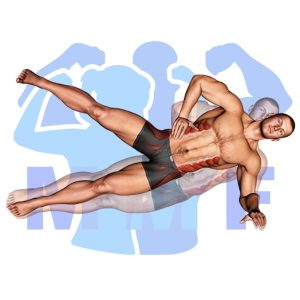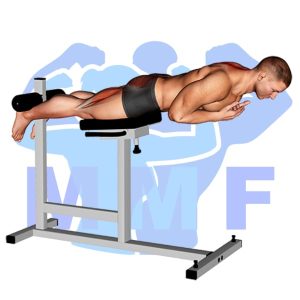Do you feel like your core workouts are getting stale? Are you struggling to see any progress despite your consistent efforts? It’s a common issue many of us face, especially when working towards defined core muscles. The problem is, many of us stick with basic ab exercises that only target specific areas and fail to engage the whole core. Fortunately, there’s a simple and effective solution – the weighted Russian twist. In this post, we’ll explore the benefits of this exercise, as well as provide a step-by-step guide on how to perform it correctly for maximum results. Say goodbye to boring core workouts and hello to a stronger, more defined midsection with the simple addition of weighted Russian twists to your routine.
Weighted Russian Twist Summary
- Primary Muscles: Obliques
- Secondary Muscles: Hip External Rotators, Psoas major, Quadratus lumborum, Iliocastalis lumborum, Iliocastalis thoracis
- Equipment: Weight
- Mechanics Type: Isolated
- Force: Pull
- Utility: Auxiliary

Weighted Russian Twist Instructions
- Sit on the floor with your knees bent and feet flat.
- Hold a weight or medicine ball in front of your chest.
- Lean back slightly and lift your feet off the ground.
- Rotate your torso to the right, bringing the weight across your body.
- Bring your torso back to the center and then rotate to the left side.
- Continue alternating sides for desired number of reps.
Video Tutorial
Weighted Russian Twist Muscles
Target (Agonist)
Synergists
- Hip External Rotators
- Iliocastalis lumborum
- Iliocastalis thoracis
- Psoas major
- Quadratus lumborum
Dynamic Stabilizers
- None
Stabilizers
- Deltoid – Lateral
- Deltoid – Posterior
- Erector Spinae
- Gluteus Maximus
- Pectoralis Major – Clavicular
- Pectoralis Major – Sternal
- Pectoralis Minor
- Rhomboids
- Trapezius – Lower
- Trapezius – Middle
- Triceps
Antagonist Stabilizers
- None

Benefits of Weighted Russian Twist
The weighted Russian Twist is an incredibly effective exercise to target the obliques in a strength training or fitness routine. This exercise helps to build up the strength and stability of the core, as well as increasing mobility and flexibility. As the weight is twisted from side to side, the obliques are forced to work hard to keep the torso stable and upright. The weighted Russian Twist also helps to activate the deep muscles of the lower back and abdomen, which can help to improve posture and reduce the risk of lower back pain.
Tips for Performing Weighted Russian Twist
Weighted Russian Twists are a great exercise to help you tone and strengthen your core muscles. If you are looking to get fit, adding this exercise to your routine can help you see results quickly. To get the most out of this exercise and its benefits, there are a few important tips to keep in mind.
- Maintain Proper Posture: It is important to ensure that you are maintaining a straight back, with your chest slightly lifted and your shoulder blades pulled back throughout the exercise. This will help to protect your lower back and give you the most effective twist.
- Keep Your Core Engaged: Engaging your core muscles will help to keep your spine in the correct position and give you a more intense workout. Make sure to draw your belly button into your spine and maintain this tension while performing the twist.
- Use a Light Weight: When first starting out, it is best to use a very light weight or no weight at all until you get comfortable with the movement. Once you have mastered the form and feel confident in performing the exercise, then increase the weight as necessary.
Benefits and Tips Video
Frequent Mistakes To Avoid
When performing a Weighted Russian Twist, it is important to ensure you are doing the exercise correctly in order to maximize its effectiveness and avoid injury. Below is a list of common mistakes to avoid when performing this exercise. It is important to avoid these mistakes in order to ensure you get the most out of your workout and stay safe.
- Not using proper form: When performing the Weighted Russian Twist exercise, it is important to keep your back straight and maintain core engagement throughout the motion. Not using proper form can increase the risk of injury.
- Using too much weight: Starting with too much weight can put too much stress on your core and back, leading to pain and injury. It is important to start with a light weight and gradually increase as your strength and coordination improve.
- Not focusing on the core: The Weighted Russian Twist is designed to target the oblique muscles in your core, so it is important to focus on engaging those muscles throughout the exercise. Focusing too much on the arms can lead to a weaker core, which can also increase the risk of injury.
Find More Weighted Exercises Here
Variations and Complementary Exercises
The exercise Weighted Russian Twist is a great way to target your core and oblique muscles. For those looking to vary or add additional exercises to their workout, here are some variations, complementary, and alternative exercises that work similar muscles.
Twisting Crunch

Twisting Crunch is an excellent complementary or alternative exercise to Weighted Russian Twist. It is a core exercise that targets the abdominal muscles, as well as the obliques and lower back. It involves performing a crunching motion while twisting your upper body from side to side, which works the entire midsection. Unlike Weighted Russian Twist, Twisting Crunch does not require any additional weight. It can be performed with minimal equipment, making it a great choice for those looking to get a core workout in the comfort of their own home.
Side Plank Hold

The Side Plank Hold is a great complementary or alternative exercise to the Weighted Russian Twist. This exercise targets the oblique muscles in the abdomen as well as the transverse abdominis, which helps to stabilize the spine. It also helps to increase overall core strength and stability. To perform this exercise, start in a plank position on one side of your body, with your feet stacked and your top arm extended straight up. Engage your core muscles and hold for 30-60 seconds before switching sides. This exercise can be modified to suit different levels of fitness by adding weights, increasing the hold time, or decreasing the hold time.
Side Plank

The Side Plank is a great complementary or alternative exercise to the Weighted Russian Twist. This exercise targets the core and works to strengthen the abdominal muscles, obliques, and glutes. To perform a Side Plank, you start on your side with your forearm and feet planted firmly on the floor. Keep your body in a straight line from your shoulder to your feet, and hold for 30 seconds or longer. This exercise is great for targeting the obliques and is an excellent addition to any workout routine.
Check Out These Top Weighted Exercises
Side Crunches

Side crunches are a great alternative or complementary exercise to the weighted Russian Twist. This exercise targets the oblique muscles, which are essential for rotational movements like the Russian Twist. To do this exercise, lie on your side with your knees bent and feet placed flat on the ground. Place one arm behind your head and the other arm in front of your chest. Lift your torso off the floor and bring your elbow towards your hip, then lower back down to starting position. This exercise works the obliques while also increasing core stability and strength. It’s a great way to add variety to your workouts and challenge your oblique muscles.
Side Bridge Hip Dip

The Side Bridge Hip Dip is a great complementary or alternative exercise to the Weighted Russian Twist. This exercise works the same core muscles, but instead of using weight, it uses bodyweight. To perform the exercise, you start in a side plank position and then lower your hips down to the floor and back up to the starting position. The Side Bridge Hip Dip strengthens the same muscles used in the Weighted Russian Twist, but it also works the glutes and hip abductors. It is a great way to add variety to your core workout and challenge your muscles in new ways.
Side Bridge Hip Abductor

The Side Bridge Hip Abductor is a great complementary or alternative exercise for the Weighted Russian Twist. It strengthens the core muscles, specifically the obliques and hip abductors, while also targeting the glutes and hamstrings. The Side Bridge Hip Abductor requires you to lie on your side and lift your hips off the ground while keeping your legs straight. This exercise can help stabilize the spine and improve balance, and is an excellent option for those who want to strengthen their core without doing weighted exercises.
Find More Abs Exercises Here
Opposing Complementary Exercises
In addition to the Weighted Russian Twist, there are a number of other exercises that work the same muscle groups but with a different focus. By alternating between exercises that focus on the same muscle groups and those that work the opposing muscles, you can create a balanced workout that gets the most out of your time in the gym. Below are some exercises that complement the Weighted Russian Twist by using opposing muscle groups.
Hyperextension

Hyper-extension is a great exercise to complement a weighted Russian Twist. The weighted Russian Twist focuses on the obliques and core, while Hyper-extension works the opposite muscle group, the lower back. This combination of exercises helps to improve overall core strength, stability and balance. Hyper-extension helps to strengthen and stabilize the lower back, making it an important part of any exercise program. By including Hyper-extension in your routine, you will be able to maximize your results from the weighted Russian Twist, as well as help to prevent injuries.
Reverse Hyperextension

Reverse Hyperextension is an excellent complement to the Weighted Russian Twist exercise because it works the opposing muscle group. Reverse Hyperextension engages the hamstrings, glutes, and lower back muscles as it involves extending the lower body from a bent-over position. This move helps to strengthen and balance the core muscles that are used in the Weighted Russian Twist, which primarily focuses on the obliques and lower abdominals. The Reverse Hyperextension is a great way to increase overall core strength and stability while also working the often neglected posterior muscle group.
Plate Hyperextension

Plate Hyperextension is a great complement to the Weighted Russian Twist exercise. It primarily works the erector spinae muscles and gluteus maximus, which are the opposing muscle group to the obliques used in the Russian Twist. The plate hyperextension strengthens and stabilizes the lower back while also providing a great stretch to the hamstrings. The exercise is performed with a weighted plate on the back while leaning forward over a bench. By alternating between exercises that target opposing muscle groups, you can get an even more effective core workout.
Core Power: Unleash Your Abs with Weighted Russian Twist
Your core is your body’s powerhouse, and a strong core not only enhances your workout performance, it also helps to prevent injury and maintain good posture. One exercise that targets your abs and obliques is the weighted Russian twist. This exercise involves twisting your torso while holding a weight, challenging your core stability and building strength. By incorporating weighted Russian twists into your workout routine, you can build a stronger, more stable core and unlock your abs’ true potential.
References: Wikipedia | ExRx.net | PubMed.gov | Comprehensive List of Abs Weighted Exercises




